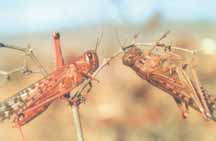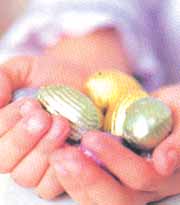
Dangerous insects
Billions of locusts have been sweeping through North and West Africa
since September 2003, devouring everything in their path. This extraordinary
invasion has been triggered by heavy rainfall and a lack of preventive
action. The African countries hit by the swarming insects have not seen such
a phenomenon for 15 years.

The French Agricultural Research Centre for International Development (CIRAD),
which had been monitoring the outbreak, has been assigned to undertake
emergency missions in Mauritania, Senegal and Niger. At the same time, it is
conducting a long-term assistance mission.
Desert locusts (Schistocerca gregaria) usually solitarious, live on the
edge of the Saharan mountain ranges. Although harmless in this form, they
are formidable when they become gregarious (large numbers getting together)
due to their voracity, mobility and the huge size of the swarms (since the
transition from the solitarious to the gregarious phase is conditioned by
the number of locusts per swarm).
A small part of an average swarm represents one tonne of locusts. Given
that one locust eats its weight in food (2g) daily, an average swarm munches
its way through as much as what 2,500 people eat every day. Swarm sizes can
vary from one square kilometre to several hundred square kilometres and can
travel over one hundred kilometres per day. In some of the countries, up to
40 per cent of grazing land and 10 per cent of leguminous crops (plants
bearing seeds in pods) have already been destroyed.
The first signs of the spreading appeared in September 2003. Abundant,
well-spread and steady rainfall gave the insects ideal breeding conditions
in Mali, Niger and Mauritania. Their numbers shot up and they made the
change from the solitarious to the gregarious phase and started to migrate
towards North Africa, where climate conditions were suited for their
breeding. They then swept through Mauritania, Senegal, Mali and then Niger,
Chad and Burkina Faso in late June-early July 2004. Some swarms even reached
the Cape Verde islands.
The UN Food and Agriculture Organisation (FAO) reports that three to four
million hectares have now been overrun. Mauritania, the hardest hit country,
is thought to have lost 50 per cent of its cereal production (due to both
the locust infestation and the drought).
The consequences of these invasions are serious and could raise fears of
famine.In early August, the agricultural ministers of five West African
countries (Mali, Mauritania, Niger, Senegal and Chad) and four North African
countries (Algeria, Libya, Morocco and Tunisia) adopted an emergency plan to
combat the desert locusts.
The North African countries sent locust control teams and equipment to
the affected countries. The participants also launched a formal appeal for
international solidarity. The FAO has already received $52.4 million to
which it has added $6 million of its own funds reserved for locust
infestations. Donors have also pledged $15 million. The organisation has
ordered over two million litres of pesticide, half of which has already been
delivered.
At the same time, long-term French assistance is being set up to develop
strategic tools to prevent and manage locust crises and improve knowledge of
areas where swarming behaviour starts. A number of meetings have already
been held and are due to take place in the coming months, attended by the
main African countries and the donors.
- Delphine Barrais
Reconstruction of schools under a monitoring system
We all know that so many schools in the country were destroyed and
damaged in the December 26 tsunami. Projects to reconstruct many of these
schools are already under way.
The Ministry of Education has now started a monitoring system to
supervise the programmes launched to reconstruct and provide relief to these
schools.
The Project Monitoring Unit, which was especially set up for this
purpose, will liaise closely with the donors who are handling school
reconstruction, and the other parties who are involved.
The Monitoring Unit is also responsible for ensuring that all land
allocations will be completed and the reconstruction of schools will begin
as early as possible. Regular meetings are held by the Unit with the donor
community, and also with a special sub-committee for donors that has been
appointed to deal closely with the project implementation team of the
Education Ministry.
A sub-committee of the Monitoring Unit is also working closely with the
Provincial authorities, to ensure that relief goods such as stationery, that
are still being sent by donors, reach needy schools.
The Ministry was also scheduled to launch a special website on March 26,
three months after the tsunami. The website will be dedicated to the school
reconstruction programme, so that those who may be interested in these
projects, whether they are local or foreign, can access information and
offer assistance.
Easter Sunday, a joyous occasion
Today is Easter Sunday, when Christians all over the world celebrate the
rising of Jesus Christ from the dead. It is also one of the most joyous
occasions for Christians and Catholics and is one of the most important days
in their calendar.

Jesus, who died on the cross on Good Friday, is believed to have risen
from the dead, three days later, on Easter Sunday.
Have you heard of the very first Easter? The story goes that three days
after Jesus' death in 29AD, Cleopas and his friend, who were disciples of
Jesus, were walking from Jerusalem to Emmaus. Their hearts were heavy as
their thoughts were filled with their leader. They started talking about a
rumour they had heard that Jesus' body, which had been nailed to the cross,
had disappeared.
They were later joined by a stranger who, upon hearing of their
discussion, told them that the Son of God had chosen to suffer on behalf of
humanity so that they will be cleansed of their sins. Soon it got dark, and
the two friends invited the stranger to stay with them for the night. When
they sat down to supper, the stranger took some bread, blessed it, broke it
and gave it to them. It was then that they recognised Jesus, who at that
very moment, disappeared from their sight. The overjoyed men ran all the way
back to Jerusalem, breaking the news that "Jesus is risen".
In the early days, Easter used to be celebrated on different dates. It
was only in 325AD that a council of churchmen decided to fix the date for
Easter as the first Sunday following the first full moon after March 21.
The Lenten period of sorrow and fasting comes to an end on this day.
Beautiful Easter lilies adorn church altars and candles are lit. Churches
all over the world celebrate the day Christ rose from the dead.
Project to restore Sigiriya fortress
The Central Cultural Fund (CCF), under the Sigiriya Conservation
Programme, has launched a project to restore King Kasyapa's fortress atop
the Sigiriya rock, which is presently in a state of ruin. The site,
considered the 'eighth wonder of the world' has now fallen into decay.
According to CCF sources, the bricks used in the fortress are now in a
dilapidated condition. They have to be replaced with new bricks produced to
the same measurements. About 500,000 bricks, each weighing about seven
kilos, are needed to restore the fort.
The CCF organised a two-day brick hoisting Shramadana campaign with the
support of 100 villagers and the officers of government institutions. Such
shramadana campaigns are expected to be held from time to time until all the
required bricks are lifted onto the rock.
Hunt for Easter eggs
Hunting for and eating Easter eggs may not be a well-rooted tradition in
Sri Lanka, but it is a custom which is observed by Christians in most other
countries. This custom, observed on Easter Sunday, is now catching on in Sri
Lanka too.

Even before Christianity arrived, coloured eggs were used in their spring
celebrations by ancient Persians, Egyptians, Romans and Greeks. This
practice may have been continued later, as the egg holds within itself the
beginning of a new life.
There was an old belief that a rabbit lays brightly coloured eggs on the
grass on Easter Sunday. Nowadays, children and parents start decorating eggs
in bright colours, in the days leading upto Easter. These eggs are hidden
outdoors by the parents on the Saturday night before Easter, and the
children hunt for them the next morning. Easter eggs are now made of things
like chocolate, sugar, and marzipan. These are simply delicious. But did you
know that the eggs are also used as play items and decorative items?
Artificial eggs are made of wood, glass and even porcelain. Eggs made to
beautiful designs have been used as gifts in some countries such as Russia.
Some of them were so beautiful and encrusted with jewellery, that they were
very expensive and had to be guarded.
|


